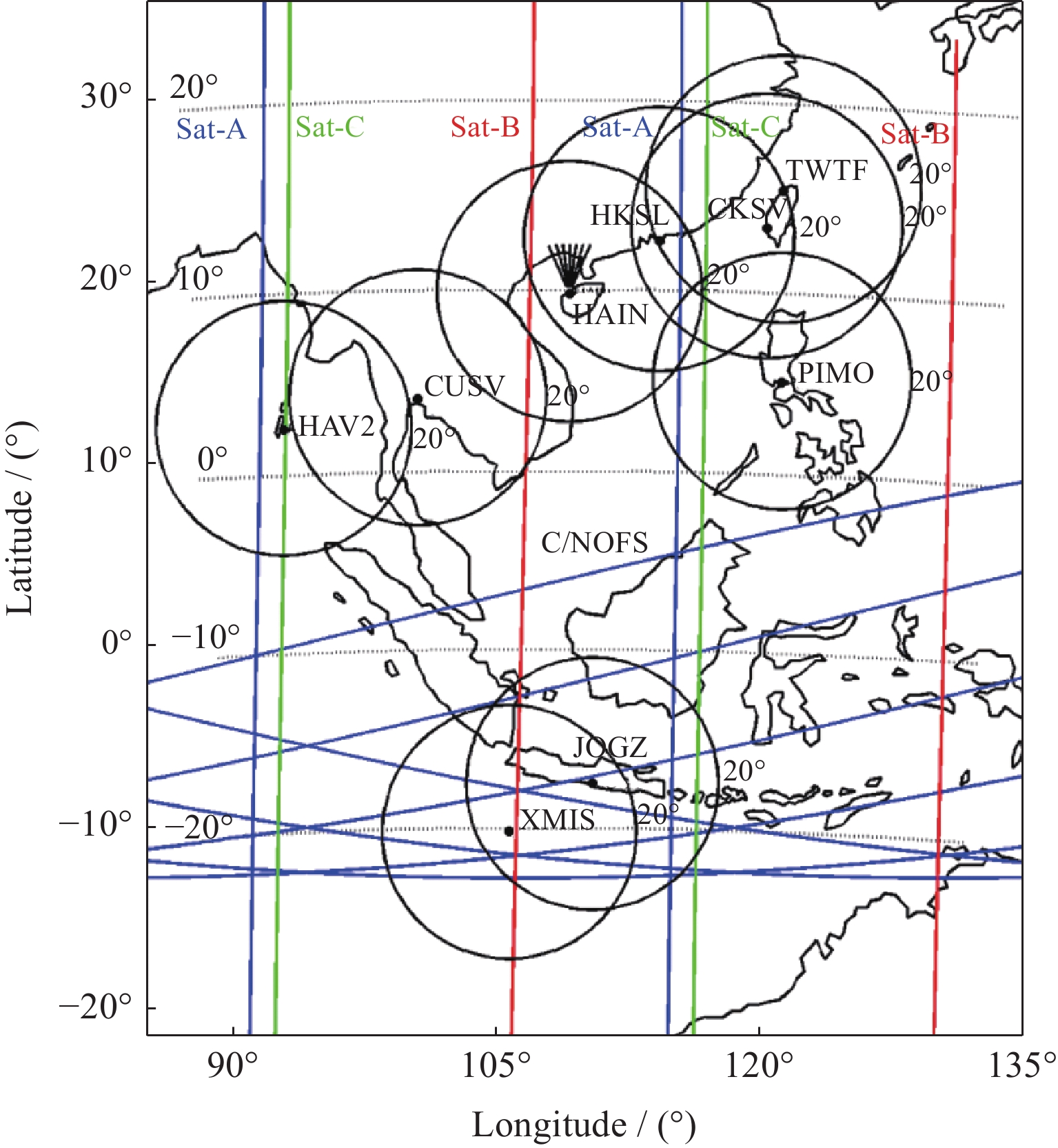夏季强对流活动对东亚低纬电离层不规则体影响的事件分析
doi: 10.11728/cjss2022.06.211228135 cstr: 32142.14.cjss2022.06.211228135
Event Analysis of the Influence of Strong Tropospheric Convection in Summer on Low-latitude Ionospheric Irregularities in East Asia
-
摘要: 利用海南台站和东南亚地区的多种地基和天基观测手段,对2014年7月28日夜间观测到的东亚低纬F区不规则体事件的时空变化及其物理过程进行分析。结果表明,海南台站观测到了罕见的长时间持续的F区电离层不规则体,不同手段观测到的电离层不规则体存在明显的形态差异。不同台站观测到的电离层不规则体活动存在明显的差异。海南台站经度区南北异常峰附近的TEC起伏活动在日落后至午夜附近明显增强,在午夜后明显减弱。C/NOFS卫星轨迹午夜后逐渐接近于磁赤道,且处于较低高度上,几乎总会观测到弱等离子体扰动/泡的发生,与该区域地基观测的弱电离层不规则体活动存在明显的联系。SWARM卫星在黎明海南台站附近经度区仍观测到较强的赤道异常双峰结构,且西侧异常峰区附近仍存在明显的等离子体密度耗空/泡结构。海南台站西侧磁赤道区附近(中南半岛)强对流活动(MCC)激发的重力波种子扰动对东亚低纬区等离子体泡及准周期结构的产生发挥了重要作用。Abstract: Using various ground-based and space-based observation methods from the Hainan station and Southeast Asia, the spatiotemporal changes and physical processes of the irregularity events in the low-latitude F region of East Asia observed on the night of July 28, 2014 were analyzed. The main results are as follows. The Hainan station observed a rare occurrence of long-lasting ionospheric irregularities in the F region, and the ionospheric irregularities observed by different means have obvious morphological differences. There are obvious differences in the activities of ionospheric irregularities observed by different stations. The TEC fluctuation activities near the north-south anomalous peaks in the longitude area of Hainan increased significantly before midnight and weakened significantly after midnight. After midnight, the trajectory of the C/NOFS satellite gradually approached magnetic equator and was at a lower altitude. The occurrence of weak plasma disturbances/bubbles was almost always observed, which is obviously related to the activities of weak ionospheric irregularities observed on the ground in this region. The SWARM satellites still observed the strong two peaks of equatorial anomaly near dawn in the longitude region near Hainan station, and there were still the plasma density depletion/bubble structures near the anomalous peak area on the west side. The seed disturbance (gravity waves) excited by the MCC near the magnetic equator on the west side of the Hainan station (Indochina Peninsula) may play an important role in the generation of plasma bubbles and their quasi periodic structures in the low latitude region of East Asia.
-
图 1 海南和东南亚台站的位置及观测范围 (7 条斜线为海南 VHF 雷达的观测方向和范围。圆圈为 GPS 电离层闪烁/TEC 监测仪的观测范围。斜横线为C/NOFS 卫星轨迹,竖线为 SWARM 卫星轨迹)
Figure 1. Location and observation range of Hainan and Southeast Asia stations. (The seven oblique lines are the observation direction and range of Hainan VHF radar. The circles are the observation area of GPS ionospheric scintillation/TEC monitors. The oblique horizontal lines are the trajectories of C/NOFS satellites, and the vertical lines are the trajectories of SWARM satellites)
-
[1] WOODMAN R F, LA HOZ C. Radar observations of F region equatorial irregularities[J]. Journal of Geophysical Research, 1976, 81(31): 5447-5466 doi: 10.1029/JA081i031p05447 [2] TSUNODA R T. Upwelling: a unit of disturbance in equatorial spread F[J]. Progress in Earth and Planetary Science, 2015, 2: 9 doi: 10.1186/s40645-015-0038-5 [3] HUANG C S. The characteristics and generation mechanism of small-amplitude and large-amplitude ESF irregularities observed by the C/NOFS satellite[J]. Journal of Geophysical Research: Space Physics, 2017, 122(8): 8959-8973 doi: 10.1002/2017JA024041 [4] TSUNODA R T. On seeding equatorial spread F during solstices[J]. Geophysical Research Letters, 2010, 37(5): L05102 doi: 10.1029/2010GL042576 [5] CHOI J M, KIL H, KWAK Y S, et al. Periodicity in the occurrence of equatorial plasma bubbles derived from the C/NOFS observations in 2008-2012[J]. Journal of Geophysical Research: Space Physics, 2017, 122(1): 1137-1145 doi: 10.1002/2016JA023528 [6] TSUNODA R T, NGUYEN T T, LE M H. Effects of tidal forcing, conductivity gradient, and active seeding on the climatology of equatorial spread F over Kwajalein[J]. Journal of Geophysical Research: Space Physics, 2015, 120(1): 632-653 doi: 10.1002/2014JA020762 [7] TSUNODA R T. On equatorial spread F: establishing a seeding hypothesis[J]. Journal of Geophysical Research: Space Physics, 2010, 115(A12): A12303 doi: 10.1029/2010JA015564 [8] HUANG C S, KELLEY M C. Nonlinear evolution of equatorial spread F: 1. On the role of plasma instabilities and spatial resonance associated with gravity wave seeding[J]. Journal of Geophysical Research: Space Physics, 1996, 101(A1): 283-292 doi: 10.1029/95JA02211 [9] LI G Z, OTSUKA Y, NING B Q, et al. Enhanced ionospheric plasma bubble generation in more active ITCZ[J]. Geophysical Research Letters, 2016, 43(6): 2389-2395 doi: 10.1002/2016GL068145 [10] PI X, MANNUCCI A J, LINDQWISTER U J, et al. Monitoring of global ionospheric irregularities using the worldwide GPS network[J]. Geophysical Research Letters, 1997, 24(18): 2283-2286 doi: 10.1029/97GL02273 [11] DE LA BEAUJARDIÈRE O, The C/NOFS Science Definition Team. C/NOFS: a mission to forecast scintillations[J]. Journal of Atmospheric and Solar-Terrestrial Physics, 2004, 66(17): 1573-1591 doi: 10.1016/j.jastp.2004.07.030 [12] XIONG C, STOLLE C, LÜHR H, et al. Scale analysis of equatorial plasma irregularities derived from swarm constellation[J]. Earth, Planets and Space, 2016, 68: 121 doi: 10.1186/s40623-016-0502-5 [13] HUANG C S, DE LA BEAUJARDIERE O, RODDY P A, et al. Generation and characteristics of equatorial plasma bubbles detected by the C/NOFS satellite near the sunset terminator[J]. Journal of Geophysical Research: Space Physics, 2012, 117(A11): A11313 doi: 10.1029/2012JA018163 [14] KELLEY M C, DAO E V. Evidence for gravity wave seeding of convective ionospheric storms possibly initiated by thunderstorms[J]. Journal of Geophysical Research: Space Physics, 2018, 123(5): 4046-4052 doi: 10.1002/2017JA024707 [15] WALISER D E, GRAHAM N E, GAUTIER C. Comparison of the highly reflective cloud and outgoing longwave radiation datasets for use in estimating tropical deep convection[J]. Journal of Climate, 1993, 6(2): 331-353 doi: 10.1175/1520-0442(1993)006<0331:COTHRC>2.0.CO;2 [16] MCCLURE J P, SINGH S, BAMGBOYE D K, et al. Occurrence of equatorial F region irregularities: evidence for tropospheric seeding[J]. Journal of Geophysical Research: Space Physics, 1998, 103(A12): 29119-29135 doi: 10.1029/98JA02749 [17] TSUNODA R T. On seeding equatorial spread F: circular gravity waves[J]. Geophysical Research Letters, 2010, 37(10): L10104 doi: 10.1029/2010GL043422 [18] CARTER B A, TULASI RAM S, YIZENGAW E, et al. Unseasonal development of post-sunset F-region irregularities over southeast Asia on 28 July 2014: 1. Forcing from above[J]. Progress in Earth and Planetary Science, 2018, 5: 10 doi: 10.1186/s40645-018-0164-y [19] AJITH K K, TULASI RAM S, CARTER B A, et al. Unseasonal development of post-sunset F-region irregularities over southeast Asia on 28 July 2014: 2. Forcing from below[J]. Progress in Earth and Planetary Science, 2018, 5: 60 doi: 10.1186/s40645-018-0218-1 -
-






 下载:
下载:










